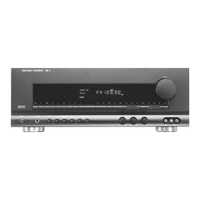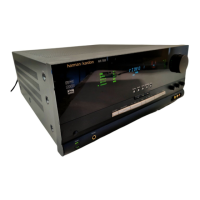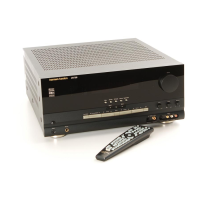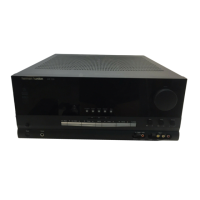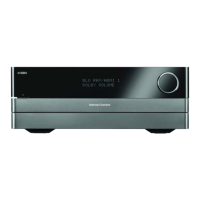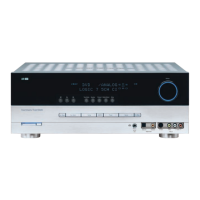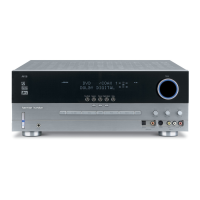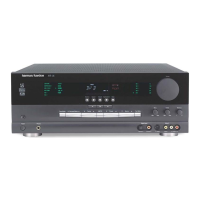16 INSTALLATION AND CONNECTIONS16 INSTALLATION AND CONNECTIONS
INSTALLATION AND CONNECTIONS
various source devices, but you may make any
connection and change the configuration setting
using the
IN/OUT SETUP menu, as
described on page 22.
6. The default video connection for a DVD player is to
use the
Component Video Input 3 Jacks Q on
the AVR, but you may change this assignment in
the
IN/OUT SETUP menu (see page 22).
A DVD player’s composite and S-video outputs may
also be connected to the
DVD Video Inputs S.
Only one connection type is required, although a
composite or S-video connection is required if the
AVR 745 is to be used in a multiroom video system.
7. The default audio connection for a DVD player is
to link the coaxial digital audio output on the DVD
player to the
Coaxial 1 Digital Audio Input d,
but you may also make a connection to either the
Coaxial d or Optical e digital inputs, or the
Analog DVD Audio Inputs c. You may change
the assignment in the
IN/OUT SETUP
menu as described on page 22, or by using the
front-panel
Digital Input Selector F.
8. If you wish to use a portable audio/video product
such as a camcorder, portable media player or
digital still camera with the AVR, or make a connec-
tion to a video game console or other source that
may not always be connected to the AVR, connect
the video outputs of the source to the
Video 4
Input/Output Jacks N that are behind the
Front-Panel Door 8. If the source has digital
audio outputs, connect them to the
Optical 4
Digital Input K or the Coaxial 4 Digital Jack M.
CONNECTION NOTES:
• When making connections to the Component
Video Inputs
Q or the Coaxial d or Optical
e digital audio inputs, it is a good idea to make
note of which jacks are connected to which
source, using the Worksheet in the Appendix. This
will help simplify the configuration process.
• When connecting a source device such as a
cable set-top box where the audio streams may
change between digital and analog as you
change channels, we recommend that you make
both analog and digital connections. The AVR’s
Auto Poll feature will automatically sense when
the digital stream is replaced by an analog output
and switch the input accordingly. (See page 22
for more information on the Auto-Poll feature.)
This dual connection is not required for sources
(such as DVD players or video games) that always
output a digital stream.
9. Connect the AVR to your video display using one of
the following connections:
• If you have a video display with an HDMI or DVI
input, make the connection using the
HDMI
Output
d, as described in the next section.
• If your video display has component video inputs
(Y/Pr/Pb), connect the
Component Video
Outputs O.
• If your display does not have digital or compo-
nent video inputs, connect the
Video Monitor
Output R on the AVR to the matching input on
your display. Only one connection is needed, and
S-video is the higher quality signal.
HDMI Connections
HDMI
™
is the abbreviation for High-Definition
Multimedia Interface, which is quickly becoming
the standard connection point between advanced
video/audio source products and displays, particularly
for high-definition video signals. HDMI is a digital con-
nection, eliminating the need to convert signals back
and forth from digital to analog to deliver a higher
quality signal when used with digital sources. The sig-
nals carried on HDMI may, but do not always, include
audio, offering the possibility of a complete one-wire
connection from a source to the AVR. However, it is
important to note that there are a number of different
versions of the HDMI standard in use. Before connect-
ing any HDMI products to your AVR, it is helpful to find
out in advance their level of HDMI connectivity.
Some source or display components in your system
may use DVI (Digital Video Interface) for digital video
connections. DVI carries the same digital video signals
as HDMI but uses a larger connector and does not
transport audio or control signals. In most cases, you
may mix and match DVI and HDMI digital video con-
nections by using optional connector adapters. Note,
however, that some DVI-equipped video displays are
not compatible with the HDCP copy protection coding
that is increasingly carried with signals connected
via HDMI. If you have an HDMI source and a DVI-
equipped display, you may occasionally be unable to
view a program if the display does not include HDCP.
This is not the fault of the AVR or your source; it sim-
ply indicates that the video display is not compatible.
HDMI Input Connections
The different “Version” levels of HDMI define which
type of audio signals it is compatible with. Based on
the lowest level of HDMI among your sources, the
connections to the AVR should be made as follows:
• HDMI 1.0 sources carry digital video and multi-
channel or 2-channel PCM audio signals only.
Connect the HDMI output of a 1.0 source to either
of the HDMI Inputs N on the AVR. If the product
is a DVD-Audio player or other source that has mul-
tichannel analog audio outputs, connect them to the
8-Channel Direct Inputs f. With an HDMI 1.0
source, particularly a DVD player, make certain
that the menus in the source device are set to
“Bitstream Out” or “Original” so that 5.1 digital audio
is available. If you find that 5.1 Dolby Digital or DTS
audio is not available on the HDMI connection, it
will be necessary to make an additional connection
between the source and the AVR 745 to either the
Coaxial dM or Optical eK Digital Inputs.
• HDMI 1.1 sources carry the multichannel digital
audio output from DVD-Audio players in addition to
the digital video. If you have an HDMI 1.1-equipped
product, the only connection needed for listening
in the main room is from the HDMI output of the
source to either of the
HDMI Inputs N on the
AVR. If the player has SACD capability, you will need
to connect the analog outputs of the source to the
8-Channel Direct Inputs f.
• HDMI 1.2
(and higher) sources should be connected
as shown above for HDMI 1.1, except that a
separate analog connection is not needed for
SACD players.
• It is not possible to feed an analog composite or
S-video signal to a recorder or the AVR’s multizone
system when an HDMI input is in use. If an HDMI-
equipped source also has analog audio and video
outputs, connect them to the
Video 2 or Video 3
Video VW and Audio hi on the AVR.
• In some instances, HDMI-equipped sources will not
permit more than one video output at a time, and
thus you cannot use the same source in the main
listening room and with the recorder or remote zone
at the same time. This is not a fault of the AVR, but
rather a function of the content protection systems
that are part of the HDMI standard.
HDMI Output Connections
Connect the HDMI Output M to an HDMI input on
your video display. Thanks to the AVR 745’s video
processing system, all video input signals are converted
to an HDMI output, so only one connection is required
between the AVR and your display.
System and Power Connections
The AVR 745 is designed for flexible use with multi-
room systems, external control components and
power amplifiers.
Main Room Remote Control Extension
If the receiver is placed behind a solid or smoked-
glass cabinet door, the obstruction may prevent the
remote sensor from receiving commands. In this
event, an optional remote sensor may be used.
Connect the output of the remote sensor to the
IR Input fl.
If other components are also prevented from receiving
remote commands, only one sensor is needed. Simply
use this unit’s sensor or a remote eye by running a
connection from the
IR Output ‹ to the Remote IR
Input jack on Harman Kardon or other compatible
equipment.
If other Harman Kardon-compatible source equipment
is part of the main room installation, the
IR
Output
Jack
‹ on the rear panel should be connected
to the
IR IN jack on source equipment. This will enable the
INSTALLATION AND CONNECTIONS
AVR 745 OM 5/15/06 5:00 PM Page 16
AVR745
harman/kardon
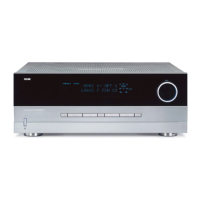
